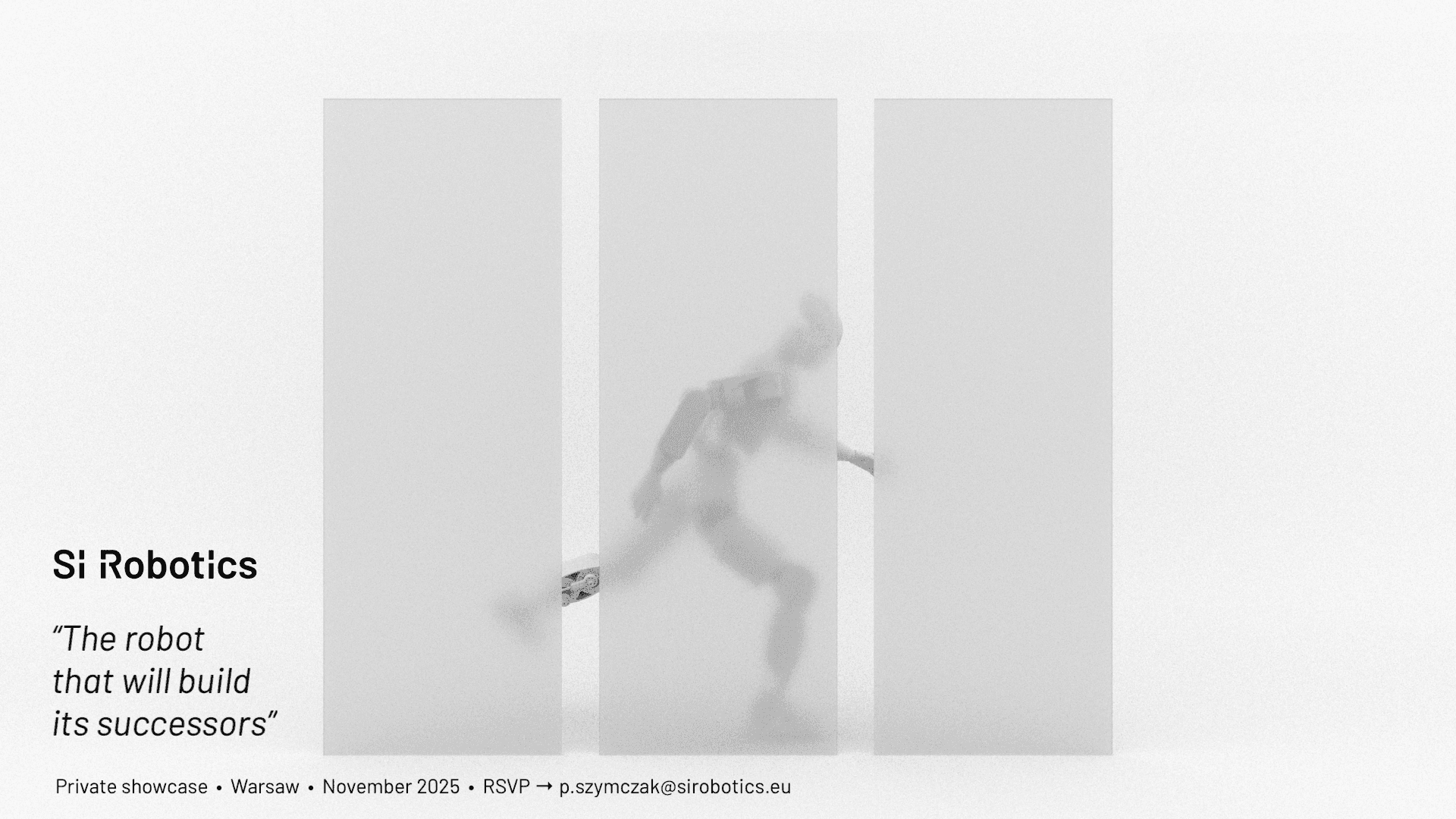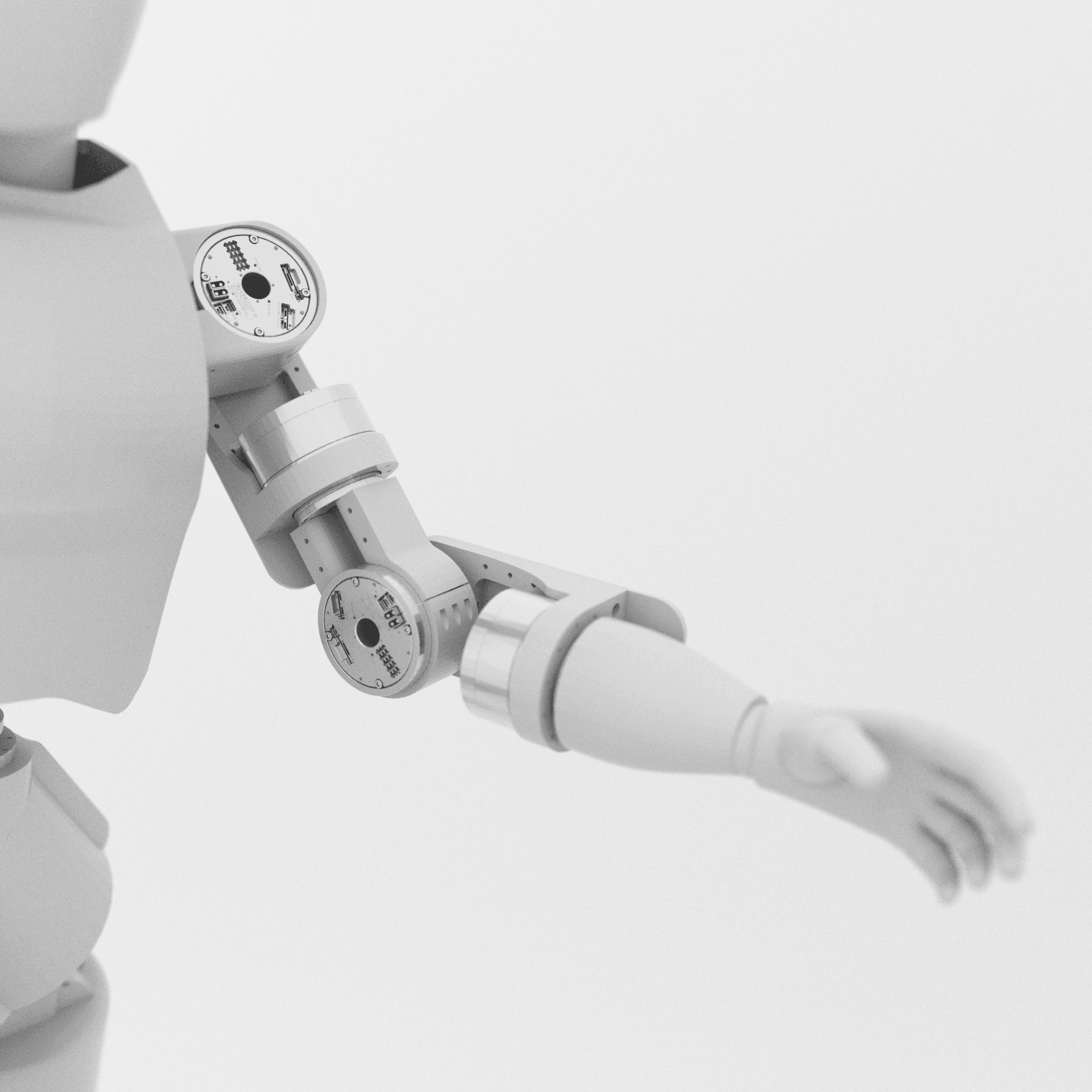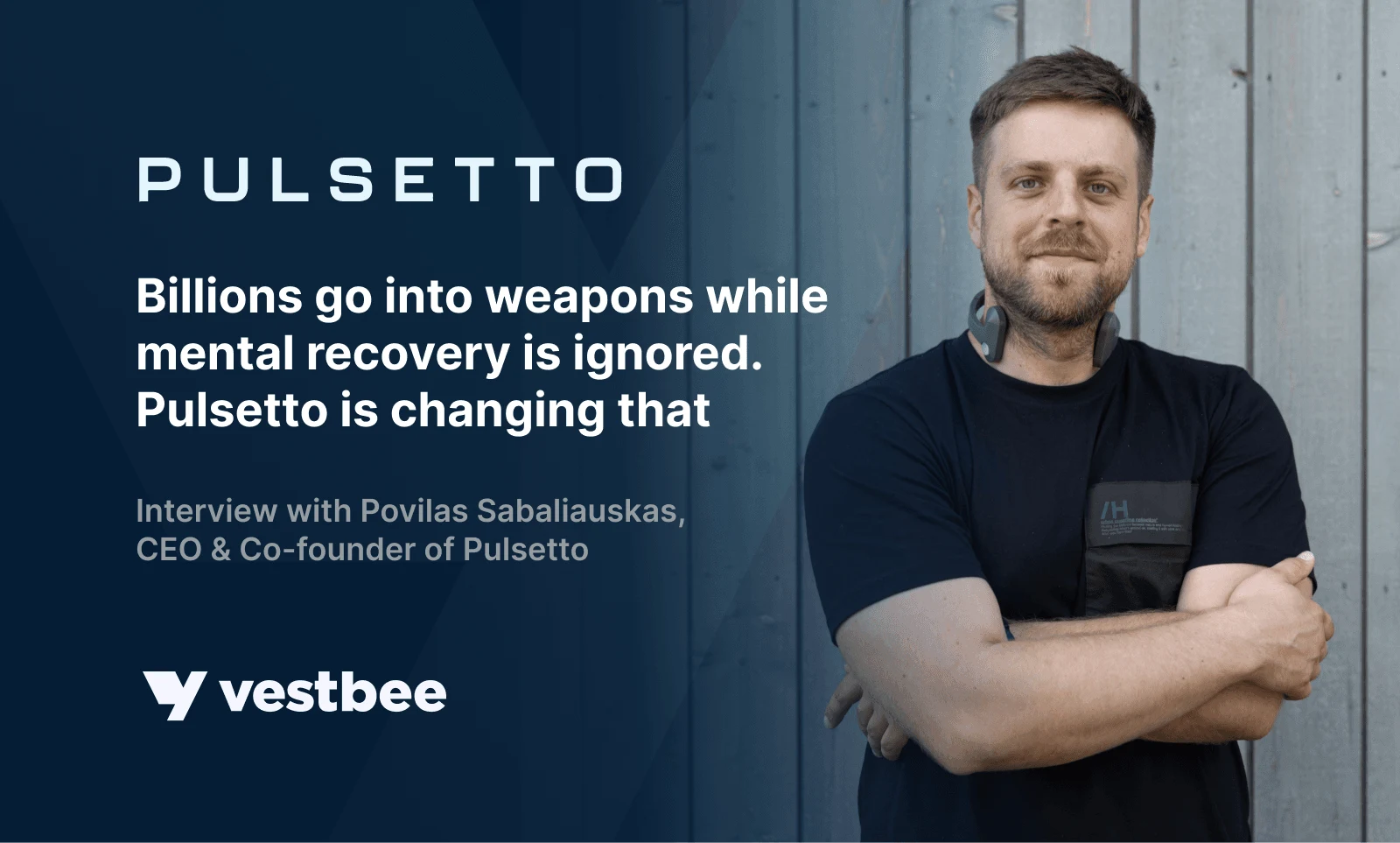Just as LLMs have transformed how machines understand text, a new Polish startup is betting on the next frontier: teaching machines to understand and interact with the physical world. SI Robotics is developing what it calls "physical AI", humanoid robots capable of learning complex manual tasks, generating proprietary datasets, and eventually assisting in the assembly of their future iterations.

While most industrial robots depend on rigid programming, SI Robotics builds systems that adapt to real-world variability. The near-term focus is defence manufacturing; over time, the same technology will support a home ‘handyman’ use case.
We spoke with Patryk Szymczak, co-founder of SI Robotics, about the startup’s origins, technology, and vision for the next 5-7 years, where robots not only perform tasks but also assist in production workflows. Their first humanoid platform is now being integrated and internally tested in Warsaw. In 2026, they anticipate reaching TRL 6 with pilots in recycling and defense assembly, and in 2027, they expect the first limited-scale, paid deployments. This November, the startup will host its first private investor showcase in Warsaw, revealing its first bipedal humanoid prototype — Joule.
For those hearing about SI Robotics for the first time, what is your company’s mission?
We build humanoid robots. In the long term, we envision these robots assisting people in their homes, but to get there, we first need to master the industrial floor.
The need is urgent. Across Europe, labor shortages are worsening due to declining birth rates and younger generations avoiding physically demanding work such as recycling, manual welding, or assembly work on the factory floor. Traditional automation can’t bridge this gap — it’s too rigid. Our robots thrive where conventional automation fails and where roles are increasingly avoided by humans.
And this is more than a business opportunity. By developing advanced Physical AI in Europe, we’re building the continent’s technological resilience — not waiting for others to define it. Our in-house lab designs and builds proprietary actuators and motion-control boards; we’ve produced and tested first pre-series sets on our own winding and balancing rigs. We are entering a decade of systemic rivalry. Competitiveness will depend on deploying humanoids at scale.
How did SI Robotics come to be?
Together with my co-founder, Kajetan, we spent a long time thinking about where our combined skills could make the biggest impact. We saw that wherever work is repetitive or damaging, humanoids will appear. At some point, we asked ourselves: “What if we’re the ones to build them?” Poland, with its deep engineering talent and proximity to NATO’s eastern flank, turned out to be an ideal place to build Physical AI. It’s where resilience and technology naturally meet. That’s where SI Robotics was born. We are expanding to London and Berlin for business development and engineering in Europe’s key hubs for defence, AI, and capital.
What problems or pain points are you addressing?
We focus on environments where classical automation doesn’t work. Factories that are already partially automated, but still employ hundreds, sometimes thousands, of people for manual tasks like assembly, transferring, and fitting components. These are high-mix production environments where products are highly variable, requiring flexibility on the line. Traditional robots simply can’t handle that.
At the same time, there’s a dramatic shortage of workers. Companies can’t maintain full production capacity. We place a robot into a missing human position and teach it the task. Today, a first task imitation takes ~8–12 weeks under supervision; our goal with data reuse is <4 weeks by late 2026 for comparable tasks.
You call yourselves a dual-use company. How do you balance defence and civilian applications? What industries or applications do you want to address?
We focus on industrial resilience across two core markets: rare-earth recycling and defence manufacturing.
The first is electric-vehicle battery recycling. Disassembling battery packs — removing casings, separating cells, cutting wiring — is still almost entirely manual. As EV adoption accelerates, demand for scalable disassembly will surge. This isn’t about “saving the planet” anymore; it’s about securing access to critical materials and keeping European industry running. It is our beachhead market, growing at roughly 22–25 percent CAGR.
Next comes defence. Our robots will take on complex manual tasks such as welding in combat-vehicle production, shipbuilding, and shelter assembly. These jobs are too variable for traditional automation, and tightly regulated facilities face structural labor shortages that will widen as European production scales.
Phase three is manual assembly of UAVs, EW systems, and trucks. In total, our near-term pipeline covers 20+ sites across recycling and defence assembly, with initial pilot scopes of 1–3 robots per site.
Over time, we see humanoid robots becoming the backbone of logistics and resilience. Imagine two units unloading ammunition, or a coordinated group supporting border operations, field maintenance, or disaster recovery. They extend human capability without replacing it.
We’re already engaged with over 20 European industrial and defence companies, with five proposals under technical evaluation and two confirmed site visits. These early pilots validate both our hardware stack and the Physical AI learning loop. The momentum is clear: capital and demand are converging across recycling and defence, and humanoid robotics is emerging as a key enabler of Europe’s industrial resilience.
Why did you decide to focus on these industries?
We chose these industries deliberately because they allow us to focus on disassembly and assembly, the core primitives of physical AI.
Why? In the world of physical AI, everything comes down to data, just as OpenAI was able to train large language models on the body of text that makes up the entire internet. But in physical robotics, such datasets are scarce and often proprietary to a few players. That’s why our first pilot clients are not just commercial projects, but above all, crucial data sources.
That’s why our projects in recycling (disassembly) and defence (assembly) are also a way to train our physical AI. Ultimately, we want these capabilities to translate into something very concrete - a robot that can work in everyday human environments. The consumer version is a by-product of mastering industrial primitives.
So how do SI Robotics’ robots learn to perform tasks, and what sets you apart from traditional industrial robots?
Our R&D team of 12 engineers has built and validated key subsystems in-house — from actuator winding and balancing rigs to embedded control boards and we’ve passed bench tests for torque tracking and low-latency control on representative joints. This foundation allows us to move from concept to hardware at exceptional speed.
Our humanoid bot, Joule, is built around 65 actuators and a proprietary balancing system. Unlike many other designs, it has a flexible spine instead of a rigid torso, giving it a more natural sense of balance. We’re building what Europe currently lacks: a fully integrated humanoid robotics stack. In the US, players like Figure and Tesla dominate the narrative; in Asia, companies such as Unitree and Fourier are scaling fast. Europe still depends on imported motors and controllers. We’re changing that by building the actuators, the electronics, and the intelligence layer here, from the ground up. This de-risks our supply chain in Europe and shortens actuator lead times from months to weeks.
What truly sets us apart is our focus on Physical AI: teaching the robot to feel its own body as naturally as it sees the world around it. Traditional robots rely on vision; they look at an object and then move to manipulate it. Joule goes beyond that. It knows where its arms and fingers are in space through proprioception, and it feels pressure, shape, and texture through haptics. It senses the tension in its wrist, elbow, and shoulder just like a living body. That awareness allows it to perform delicate actions, like pulling a wallet from a pocket or separating objects in its hand, without the need to look.
Most companies treat the hand as a tool and the body as a transport system. We see them as a single organism. True humanoid intelligence cannot emerge from modular shortcuts. It must be embodied, connected, and alive in motion. That is what Physical AI really means to us, and that is what we are building.
We aim to deploy this capability in defence assembly and EV battery recycling, where tasks are complex, variable, and data-rich. Every movement, applied force, and joint angle is recorded, creating a dataset flywheel: the more robots we deploy, the more data we collect, and the faster our models improve. Each industrial deployment generates over 1 million motion events monthly and supports a paid pilot structure (integration fee + monthly per-robot service) that finances continued data collection.
What are your key milestones in the near and longer term?
In November 2025, in Warsaw, we’ll unveil our first bipedal robot — a full-scale prototype already walking autonomously. The private investor preview will also include live demonstrations of actuator performance and motion AI balancing systems. It will support human-guided operation while demonstrating the core principles of Physical AI, such as balance, coordination, and adaptive motion.
This moment is more than a demonstration. It shows that we can move faster, execute sharply, and scale hardware with the same speed and precision usually reserved for software companies. We have built every layer in-house, from actuators to control systems, achieving results that most teams reach only after years and with far larger budgets.
At this stage, the robot is still limited in its tasks. It cannot weld or assemble yet, but it can already navigate a real production environment under human guidance. By 2026, we will begin teaching it to perform atomic industrial operations (screwdriving, fitting, assisted TIG/MIG), independently, step by step, until it becomes a reliable, autonomous worker.
For us, this is where vision turns into execution. For investors, it is a rare early entry into a category-defining company.
What does your roadmap and scaling strategy look like? Robotics is often seen as a capital-intensive sector, so how do you plan to grow without massive funding?
We’re proving that full-stack robotics doesn’t have to be capital-intensive. By vertically integrating actuators, electronics, and motion AI, we reduce external dependency and scale faster than legacy hardware startups. I want to show that this business doesn’t necessarily require enormous capital outlays
By fully controlling the design and production of actuators and electronics, we minimize dependency on external suppliers and cut costs. We’re not building one monolithic AI to do everything; instead, we develop small, specialized models, each trained efficiently for specific industrial use cases.
Each deployed robot is both a product and a training platform for the next. This compounding approach keeps capex low and scalable within European and NATO-aligned ecosystems.
And how does this tie into your funding roadmap?
We’re closing our pre-seed round now to fund actuator production and first pilot deployments. The next funding phase in 2026 will scale pilots to 10 sites and reach TRL 7. The investor showcases, industrial pilots, and the datasets we’re accumulating form the foundation that demonstrates to VCs that our business is scalable, defensible, and technologically robust.
Did you get any market verification for your robot? What are some of the early successes of SI Robotics?
Over the past few months, we’ve been in active discussions with the industry. We’re currently working with several European recycling companies and more than 20 defence companies. Five proposals are under technical evaluation, and two site visits are scheduled. Beyond Poland, our near-term focus includes France, the United Kingdom, Germany, and the Nordics. Each pilot is scored on three KPIs: task success rate, cycle time vs human baseline, and safe-shutdown MTBF; we commit to publishing anonymised results.
We are also extending our technology into the space sector, where the same core competencies in actuation, disassembly, and precise tool operation are directly applicable to satellite servicing and on-orbit maintenance. We currently have four projects in the ESA pipeline, each aligned with the agency’s roadmap priorities for affordable, high-performance actuation systems. Space is a stress-test vertical for actuators and control; we keep it strictly as validation that feeds back into industrial reliability.

How do you see the future of the humanoid robots market and your place in it?
Right outside my window, there’s a parking lot, maybe a hundred cars of different brands. We believe robots in Europe will follow a similar pattern. Given how early the market is, we can realistically compete for leadership in high-mix industrial tasks. We expect multiple leaders to emerge by use case and supply-chain control. The market will polarize and segment, and the winners will be those who find their right niche. We intend to be one of those champions.
Much of the category still optimizes for storytelling over execution. Many projects look impressive on the surface, yet lack the foundation needed to scale. The truth is simple. Without building Physical AI from the ground up, and without owning the manufacturing stack that allows scalability, every ambitious concept eventually hits a wall.
More on SI Robotics
In November, during a private event for selected investors in our Warsaw lab, we’ll showcase the first bipedal robot demonstrating the core principles of Physical AI. This marks the beginning of our pre-seed closing phase — we’re now welcoming selected co-investors aligned with our long-term mission.
We invite investors who share our long-term mission and bring strategic access — industrial networks, defence expertise, or deeptech scaling experience — to help us turn Physical AI into Europe’s next core industry.
Investors and partners interested in attending the Warsaw showcase can contact me directly at p.szymczak@sirobotics.eu or via LinkedIn. RSVP by 5 November.








